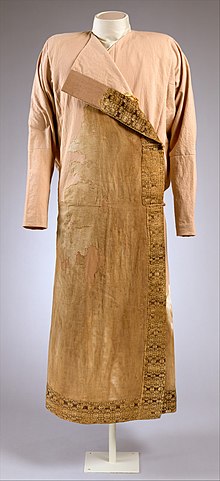Saltovo-Mayaki

Saltovo-Mayaki or Saltovo-Majaki is the name given by archaeologists to the early medieval culture of the Pontic steppe region roughly between the Don and the Dnieper Rivers, flourishing roughly between the years of 700 and 950.[1] The culture's type sites are Mayatskoye (aka Mayaki) near the Don and Verkhnii Saltiv by the Donets.[2]: 30, 37
History
[edit]Saltovo-Mayaki influence was strong in the area of the Volyntsevo culture to the northwest of the main Saltovo-Mayaki territory. There is no consensus as to what ethnicity to assign to this culture, if any at all.[3][4]
Characteristics
[edit]The Saltovo-Mayaki material culture was "fairly uniform" across the various tribes.[5]
Ethnicity
[edit]Their culture was a melting pot of Onogur, Khazar, Pecheneg, Magyar, Alan, and Slavic influences.[citation needed]
Genetics
[edit]A genetic study published in Nature in May 2018 examined three males of the Saltovo-Mayaki culture buried in Belgorod Oblast, Russia between ca. 700 AD and 900 AD.[6] The sample of Y-DNA extracted belonged to haplogroup R1.[7] The three samples of mtDNA extracted belonged to the haplogroups I, J1b4 and U7a4.[8]
References
[edit]- ^ Brook, Kevin Alan (27 September 2006). The Jews of Khazaria. Rowman & Littlefield Publishers. pp. 35–36. ISBN 9781442203020. Retrieved 30 May 2017.
- ^ Brook, Kevin Alan (2018). The Jews of Khazaria. London: Rowman & Littlefield Publishers. ISBN 9781538103432. Retrieved 25 January 2023.
- ^ Afanas'Ev, Gennady E. (2018). "Where is the Archeological Evidence of the Existence of a Khazar State?". Anthropology & Archeology of Eurasia. 57 (3): 166–189. doi:10.1080/10611959.2018.1513287. S2CID 149544774.
- ^ Bozena Werbart. "Khazars or "Saltovo-Majaki Culture"? Prejudices about Archaeology and Ethnicity".
- ^ Knauer, Elfriede R. (2001). "A Man's Caftan and Leggings from the North Caucasus of the Eighth to Tenth Century: A Genealogical Study". Metropolitan Museum Journal. 36. The University of Chicago Press: 125–154. doi:10.2307/1513059. JSTOR 1513059. S2CID 193031322.
- ^ Damgaard et al. 2018, Supplementary Table 2, Rows 106-108.
- ^ Damgaard et al. 2018, Supplementary Table 9, Row 74.
- ^ Damgaard et al. 2018, Supplementary Table 8, Rows 46-48.
Sources
[edit]- Damgaard, P. B.; et al. (May 9, 2018). "137 ancient human genomes from across the Eurasian steppes". Nature. 557 (7705). Nature Research: 369–373. Bibcode:2018Natur.557..369D. doi:10.1038/s41586-018-0094-2. hdl:1887/3202709. PMID 29743675. S2CID 13670282. Retrieved April 11, 2020.
| Khazar rulers | ||
|---|---|---|
| Other figures | ||
| Places | ||
| Tributaries | ||
| Scholars | ||
| Legacy | ||
Text is available under the CC BY-SA 4.0 license; additional terms may apply.
Images, videos and audio are available under their respective licenses.

